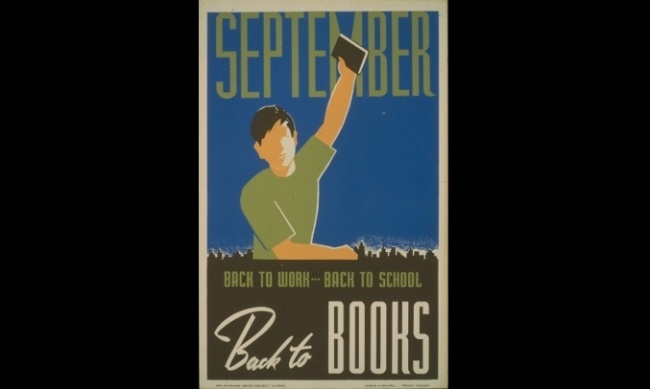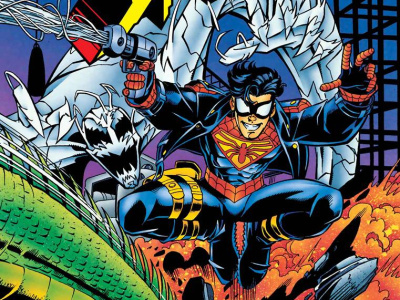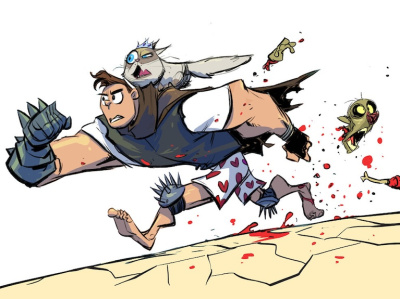With leaves starting to change, thoughts of the beginning of the school year come to mind. There are some traditional opportunities to take advantage of this as a comic shop, but there are also new ones emerging.
On the newer front, more and more colleges and community colleges are offering courses that either are about comics as literature and art or creating comics. In the New York area I’ve taught them at Columbia, Pace and Princeton, and the list of my fellow comics pros who teach is long and impressive. (I’m even moderating a panel at Pace just before NY Comic Con entitled "Those Who Can, Teach" with Klaus Janson, Phil Jimenez, Mark Newgarden and Kriota Willberg; info here. It’s not just ‘second career’ creators teaching these classes, either. Many traditional educators are interested in comics now, and are using them in a variety of ways in college classrooms. There’s a growing number of programs looking at graphic medicine now. (Not comics as cure-all, but as a tool to try to help people understand and manage their ailments.) All of these courses present opportunities to offer the “textbooks” at a discount, and in many instances you can connect with the teachers to arrange a field trip to the store or a guest lecture in the class, offering your unusual perspectives on the field.
More traditionally, for those shops near campuses (and so many comic shops have thrived in college towns over the years), there’s a literal army of potential new customers arriving with the beginning of the new school year. There are low cost/low impact ways to reach out (discount coupons in the school paper or on the school website if either accepts advertising, or flyers handed out at key spots on campus), or ways to make a bigger splash (team up with a local movie theatre for a special screening, offering a free comic and a follow up coupon to each attendee). At the very least, make that first Wednesday as appealing as possible to the newcomers, and check out if you can get into the school’s "campus cash" or similar program where local merchants accept payment through the school ID card.
It’s not only higher ed that offers opportunities, though. The explosion of successful kids graphic novels in the past decade has created a large new potential customer base for comic shops. It’s not without its challenges: youngest kids can’t come to the stores by themselves, and making a shop comfortable for non-comics-oriented parents may require some adjustments. But if you’re not using Raina’s comics as bait to lure in your next generation, you’re missing out. Think about at least one window facing full of kid-friendly and inviting blow-ups of covers or other temptations. There are also serious comics providing serious education to young people, most notably the March trilogy and Maus. Literally hundreds of thousands of young people are reading those books every year now; wouldn’t you like to capture your share of those sales? School and comics aren’t about using Classics Illustrated for your book report now.
And those schools offer retail opportunities too, though they have to be carefully arranged. Virtually every Parent Teacher Association hunts for fund-raising opportunities, and many will work with Scholastic Book Fairs for an event. Scholastic does a great job selling graphic novels there, not only their own publications but those of other kid-friendly publishers. But you may be able to reach out to the PTA and do your own, graphic novel-specific fair, offering a share of the proceeds to the organization, discounted pricing, and a selection curated to match local tastes.
The bottom line: most teachers aren’t comics-hostile any more, and any place where large numbers of potential new customers gather is a place you should try to be. Back to school, folks!
The opinions expressed in this column are solely those of the writer, and do not necessarily reflect the views of the editorial staff of ICv2.com.

Column by Paul Levitz
Posted by Paul Levitz on August 12, 2018 @ 11:50 pm CT
MORE COMICS
Part of 1996 Marvel/DC Crossover
August 1, 2025
Writer Karl Kesel and artist Mike Wieringo are the creative team for the one-shot comic, which was first published in 1996 in the middle of a Marvel/DC crossover.
Crowdfunding Campaign Launches in October, Followed by Retail Release
August 1, 2025
Vault will crowdfund the graphic novel on the Backerkit platform in October, then release it to retail.
MORE COLUMNS
Column by Scott Thorne
July 28, 2025
This week, columnist Scott Thorne comments on the Edge of Eternities prerelease and on Magic: The Gathering news from the Hasbro earnings report.
Column by Rob Salkowitz
July 21, 2025
Columnist Rob Salkowitz lays out the Comic-Con panels of interest to industry professionals, current and aspiring creatives, educators, librarians and retailers.








